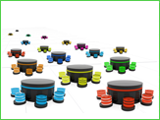The value and scale of information grows unstoppably and data centers must size-up if they are to adequately meet their operational requirements.
 The widespread use of cloud computing and Big Data comes hand-in-hand with the need for data storage, computing and networking facilities capable of ensuring a reliable and secure infrastructure for information systems to operate on. Due to the high energy demands of data centers and their corresponding networks, resource consumption has become a challenging concern that may hinder further development of network and data center systems. At present, typical resource utilization is about 5% to 25% according to some statistics. Future data center design, management, and applications must tackle the need for sufficient energy efficiency if their growth is not to be associated to environmental damage.
The widespread use of cloud computing and Big Data comes hand-in-hand with the need for data storage, computing and networking facilities capable of ensuring a reliable and secure infrastructure for information systems to operate on. Due to the high energy demands of data centers and their corresponding networks, resource consumption has become a challenging concern that may hinder further development of network and data center systems. At present, typical resource utilization is about 5% to 25% according to some statistics. Future data center design, management, and applications must tackle the need for sufficient energy efficiency if their growth is not to be associated to environmental damage.
In view of the above scenario, an international cooperation ICT research project has been established and is supported by the National Natural Science Foundation of China. The objective of this research is to reduce currently high and inefficient energy consumption on data centers from the perspective of job scheduling and resource management.
The international research team already at work includes scientists from the Chinese Academy of Sciences and Huazhong University of Science and Technology in China, IMDEA Networks Institute in Spain, and Temple University as well as University of California, Riverside in the USA.
Initial investigations made on the characteristics of power consumption by data center servers have yielded results to be applied to the energy-efficient technical design of data centers. The team has also developed routing schemes for data center networks that increase energy savings. Furthermore, a carbon-aware online control model for geographically distributed datacenters is being developed, where electricity costs, service level agreement (SLA) requirements, and an emission reduction budget are taken into consideration.
This internationally coordinated research project will last 5 years. Its findings and developed techniques aim to achieve a double objective: make data centers greener, thanks to reduced energy consumption and lesser CO2 emissions, whilst maintaining satisfactory service levels. The team of researchers hopes that, thanks to this work, we can all continue to enjoy the convenience of using data centers, without diminishing our enjoyment of a clean and cared for environment.
Project partners have already made important progress. Here are some examples:
-
They have proposed a distributed routing scheme -HDEER- to improve network energy efficiency in a distributed manner without significantly compromising traffic delay. HDEER is a two-stage routing scheme where a simple distributed multi-path finding algorithm is firstly performed to guarantee loop-free routing, and then a distributed routing algorithm is executed for energy-efficient routing in each node among the multiple loop-free paths.
-
They have developed a carbon-aware online control model for geographically distributed datacenters. In this model, they have jointly considered the electricity cost, service level agreement (SLA) requirements, and an emission reduction budget. To navigate such a three-way tradeoff, they have taken advantage of Lyapunov optimization techniques to design and analyze a carbon-aware control framework, which makes online decisions on geographical load balancing, capacity right-sizing, and server speed scaling.
-
They have been working on characterizing the power consumption of data center servers through the performance of real measurements. Based on these results, they have defined power minimization problems in which the challenge is to assign virtual machines (VMs) to physical machines (PMs) in the most efficient way. Specifically, they have studied hardness and online competitiveness for a variety of cases. To the best of our knowledge, this is the first comprehensive study of the virtual machines assignment problem for such a cost function.
-
They have formally introduced a new category of Data Center Network (DCN) architectures: the dual-centric DCN architectures, where routing intelligence can be placed on both switches and servers. Then they have proposed two typical dualcentric DCN architectures: FSquare and FRectangle, both of which are based on the folded Clos topology.
-
They have held an international workshop about High Efficiency Datacenters in June 22, 2016 at the Institute of Computing Technology (ICT) in Beijing. In this workshop, Prof. Liu from ICT, Prof. Jie Wu from Temple University and Prof. Hai Jin from HUST, as the keynote speakers, have introduced their groups’ research progress. Also, Prof. Liu and Prof. Fa Zhang visited the IMDEA Networks Institute in Madrid from July 12 to 16, 2016.
Contact point for technical enquiries: Antonio Fernández Anta, Research Professor at IMDEA Networks Institute

